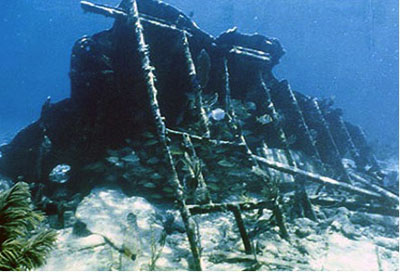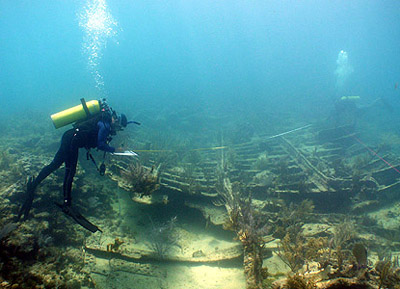
Park offers tours of Maritime Heritage Trail
HOMESTEAD, Fla. — Florida’s Biscayne National Park will be offering ranger-guided snorkel trips to selected sites of the Maritime Heritage Underwater Trail. This new attraction will allow park visitors to explore the remains of some of the park’s many shipwrecks.
“After months of planning, Biscayne National Park will be offering guided snorkel trips through the Maritime Heritage Trail starting Saturday, May 7,” said Park Ranger Astrid Rybeck.
With shipwrecks dating from to the 18th century to the 1960s, snorkelers will be able to visit six of the park’s shipwrecks, which were recently prepared snorkelers and scuba divers to discover. This project is a part of the National Park Service’s initiative to interpret and preserve American maritime history.
| Divers explore the remains of the Arratoon Apcar (Photo by Brenda Lazendorf, courtesy of the National Park Service). |  |
The Maritime Heritage Program is a subdivision of the National Park Service that works to advance the awareness and understanding of the role of maritime affairs in U.S. history. This bureau works to maintain historic U.S. shipwrecks and maritime properties, educate the public, and fund related park projects such as Biscayne National Park’s underwater trail.
“We’ve been planning on organizing guided snorkeling trips through the shipwreck sites for a very long time,” says park ranger Gary Bremen. Recent renovations to the sites include mapping of the sites, installation of mooring buoys, and installation of waterproof site cards for each wreck.
Of the dozen or so shipwrecks that lie on park premises, five of the six shipwrecks featured in the trail include the Arratoon Apcar (1878), the Erl King (1891), the Alicia (1905), the Lugano (1913), and the Mandalay (1966). The park intends to continue renovating and opening shipwrecks to the public, such as the 2002 discovery of the missing yacht Esmeralda, which sank during the devastating 1926 hurricane.
Access to the maritime sites is available by boat only. Starting May 7, 2011, visitors can reserve and purchase a snorkeling package, which includes a park ranger-guided boat ride to the sites as well as all necessary equipment (masks, fins, snorkel and snorkel vest) at a $45 fee. This three-hour guided adventure is scheduled for every Saturday from 10 a.m. to 1:30 p.m.
 |
The Mandalay shipwreck rests in shallow water, which makes it a great snorkeling site (Photo by Brenda Lazendorf, courtesy of the National Park Service). |
“On every guided tour, a park ranger will provide an history and background information about the park before embarking on an adventure through selected shipwrecks on to the park’s Maritime Heritage Trail,” said Rybeck.
Though all visitors — whether experienced or novice snorkelers — are expected to enjoy the tour, all participants must be able to swim. Many of the shipwrecks are deep underwater, while the Mandalay is more easily accessible to snorkelers due to its location on shallow water.
Though the guided tours are organized to bring curious snorkelers closer to history, the trips will also allow visitors to experience South Florida’s marine life that develops in a shipwreck.
“Biscayne’s underwater trail sounds like an diver’s dream come true,” says diving enthusiast and member of the Active Divers Association Chris Anthony. “Not only would diving around shipwrecks bring out the archaeologist in anyone, but it will let snorkelers learn about the fish and coral that make the wrecks their home.”
The Maritime Heritage Program also works at preserving historic lighthouses, such as the Fowey Rocks Lighthouse. This structure, built in 1878, is still operational today and is maintained by the U.S. Coast Guard. The lighthouse is a prominent actor in Biscayne shipwreck history, and would make a great end to a snorkeling adventure.
The Arratoon Apcar (1878)
This Scottish-built vessel sank on Feb. 17, 1878, on the Fowey Rocks reef in Biscayne National Park. Sailing from Havana to Liverpool, this iron-hulled steamship ran aground due to a miscalculation of position. Ironically, the Cape Florida lighthouse was considered inadequate because of its distance from the reef line in the 1870s, which prompted the construction of the historic Fowey Rocks Lighthouse.
Today, the remains of the Arratoon Apcar rests in ten to twenty feet of water near the Fowey Rocks lighthouse. Remains include the lower hull and iron beams of the steamship, which are now covered in coral and inhabited by colorful fish. This wreck’s shallow depth makes it a great site for diving and snorkeling.
| At right, marine archaeologist David Choate maps the wreck of the Erl King (Photo by CMAR, courtesy of Biscayne National Park). Below, a father and son snorkel over the Mandalay shipwreck (Photo courtesy of the National Park Service). |  |
The Erl King (1891)
This steamship foundered on the Long Reef in Biscayne National Park in 1891, while it was on its way to New Orleans from England. The Erl King’s hull and some cargo remains can now be explored by divers under 18 feet of water on the Long Reef. This shipwreck illustrates the early transition from wooden shipbuilding to steel construction.
The Alicia (1905)
Sailing from Liverpool to Havana, this steamship sank on the Long Reef during a violent storm in 1905. This ship carried luxury cargo including fine silks, linens, silverware, household furniture, machetes, paint, pianos, wine, English ale and liquor, shoes, buggies, harnesses and even an iron bridge. The whole of its cargo was valued in over one million dollars.
The Lugano (1913)
The Lugano shipwreck was the largest vessel to ever founder in the Florida Keys. Now lying under 25 feet of water on Long Reef in Biscayne National Park, this British steamer was headed to Havana from Liverpool included cargo of fine silks, wines, rice and other foods. In 1913, it carried 116 passengers, 12 of whom were women and children en route to Cuba. This shipwreck was infamous for the common theft and pillage of the salvaged cargo by Key West wreckers, including linens and 350 cases of brandy. Rumors of these thefts then provoked the U.S. Customs department to dispatch officials to survey the wreck.
 The Mandalay (1966)
The Mandalay (1966)
The Mandalay schooner sank on Long Reef in 1966, while sailing between the Bahamas to Miami with 23 vacationers and 12 crewmembers. Today, this shipwreck is considered one of the best shallow dive spots in Biscayne National Park. Once a beauty outfitted in mahogany, brass and ivory, this leisure schooner had three single staterooms, each with a bath and individual ventilation. On early hours of New Year’s Day, the passengers were awakened when the Mandalay was driven hard onto the Long Reef due to the captain’s miscalculation of position.
Upon its foundering, helicopters lifted 24 passengers and flew them over to safety at Homestead Air Force Base. The ship, however, was not left as unharmed as its passengers. Scavengers who stole the ship’s compass, sextant and chronometers, as well as passenger cameras, watches and purses stripped Mandalay completely. Today, snorkelers can enjoy the schooner’s remains and colorful sea life that now inhabit it.
If You Go
- Where: Biscayne National Park. All trips depart from the park’s Dante Fascell Visitor Center, nine miles east of Homestead, Fla.
- When: Every Saturday from 10 a.m. to 1:30 p.m. beginning May 7, 2011.
- Who: Contact Astrid Rybeck at 305-230-1144, ext. 017, or call the park’s concessioner at 305-230-1100.
- Visit the Web site at http://www.biscayneunderwater.com for tour reservations. Space is limited and tours are subject to cancellation due to weather, marine conditions and/or passenger minimums.

Comments are Closed